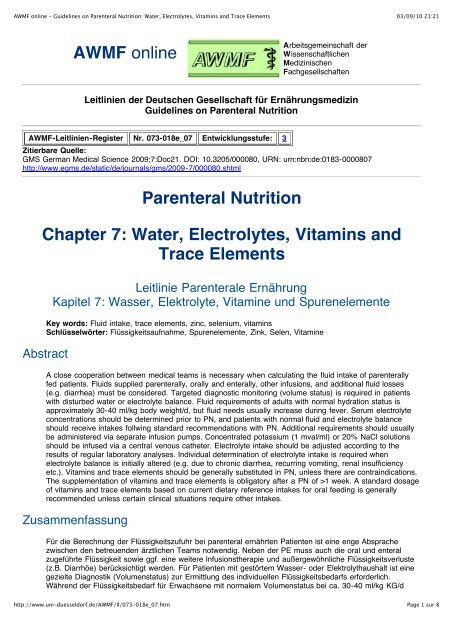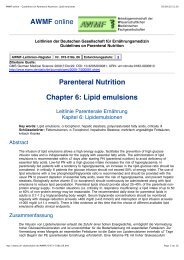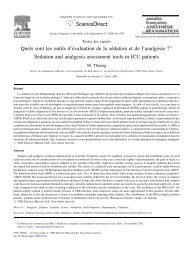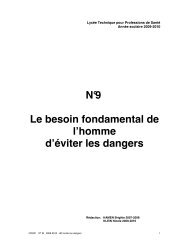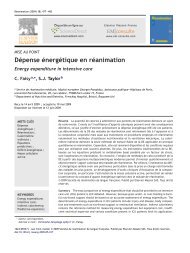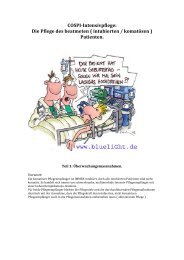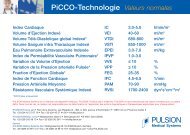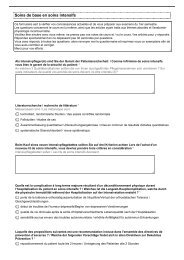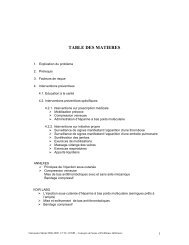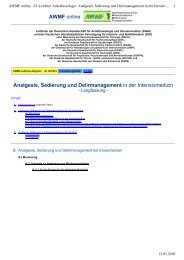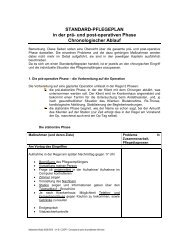AWMF online - Guidelines on Parenteral Nutrition ... - ferronfred.eu
AWMF online - Guidelines on Parenteral Nutrition ... - ferronfred.eu
AWMF online - Guidelines on Parenteral Nutrition ... - ferronfred.eu
You also want an ePaper? Increase the reach of your titles
YUMPU automatically turns print PDFs into web optimized ePapers that Google loves.
<str<strong>on</strong>g>AWMF</str<strong>on</strong>g> <str<strong>on</strong>g><strong>on</strong>line</str<strong>on</strong>g> - <str<strong>on</strong>g>Guidelines</str<strong>on</strong>g> <strong>on</strong> <strong>Parenteral</strong> Nutriti<strong>on</strong>: Water, Electrolytes, Vitamins and Trace Elements<br />
03/09/10 21:21<br />
<str<strong>on</strong>g>AWMF</str<strong>on</strong>g> <str<strong>on</strong>g><strong>on</strong>line</str<strong>on</strong>g><br />
Arbeitsgemeinschaft der<br />
Wissenschaftlichen<br />
Medizinischen<br />
Fachgesellschaften<br />
Leitlinien der D<strong>eu</strong>tschen Gesellschaft für Ernährungsmedizin<br />
<str<strong>on</strong>g>Guidelines</str<strong>on</strong>g> <strong>on</strong> <strong>Parenteral</strong> Nutriti<strong>on</strong><br />
<str<strong>on</strong>g>AWMF</str<strong>on</strong>g>-Leitlinien-Register Nr. 073-018e_07 Entwicklungsstufe: 3<br />
Zitierbare Quelle:<br />
GMS German Medical Science 2009;7:Doc21. DOI: 10.3205/000080, URN: urn:nbn:de:0183-0000807<br />
http://www.egms.de/static/de/journals/gms/2009-7/000080.shtml<br />
<strong>Parenteral</strong> Nutriti<strong>on</strong><br />
Chapter 7: Water, Electrolytes, Vitamins and<br />
Trace Elements<br />
Leitlinie <strong>Parenteral</strong>e Ernährung<br />
Kapitel 7: Wasser, Elektrolyte, Vitamine und Spurenelemente<br />
Key words: Fluid intake, trace elements, zinc, selenium, vitamins<br />
Schlüsselwörter: Flüssigkeitsaufnahme, Spurenelemente, Zink, Selen, Vitamine<br />
Abstract<br />
A close cooperati<strong>on</strong> between medical teams is necessary when calculating the fluid intake of parenterally<br />
fed patients. Fluids supplied parenterally, orally and enterally, other infusi<strong>on</strong>s, and additi<strong>on</strong>al fluid losses<br />
(e.g. diarrhea) must be c<strong>on</strong>sidered. Targeted diagnostic m<strong>on</strong>itoring (volume status) is required in patients<br />
with disturbed water or electrolyte balance. Fluid requirements of adults with normal hydrati<strong>on</strong> status is<br />
approximately 30-40 ml/kg body weight/d, but fluid needs usually increase during fever. Serum electrolyte<br />
c<strong>on</strong>centrati<strong>on</strong>s should be determined prior to PN, and patients with normal fluid and electrolyte balance<br />
should receive intakes follwing standard recommendati<strong>on</strong>s with PN. Additi<strong>on</strong>al requirements should usually<br />
be administered via separate infusi<strong>on</strong> pumps. C<strong>on</strong>centrated potassium (1 mval/ml) or 20% NaCl soluti<strong>on</strong>s<br />
should be infused via a central venous catheter. Electrolyte intake should be adjusted according to the<br />
results of regular laboratory analyses. Individual determinati<strong>on</strong> of electrolyte intake is required when<br />
electrolyte balance is initially altered (e.g. due to chr<strong>on</strong>ic diarrhea, recurring vomiting, renal insufficiency<br />
etc.). Vitamins and trace elements should be generally substituted in PN, unless there are c<strong>on</strong>traindicati<strong>on</strong>s.<br />
The supplementati<strong>on</strong> of vitamins and trace elements is obligatory after a PN of >1 week. A standard dosage<br />
of vitamins and trace elements based <strong>on</strong> current dietary reference intakes for oral feeding is generally<br />
recommended unless certain clinical situati<strong>on</strong>s require other intakes.<br />
Zusammenfassung<br />
Für die Berechnung der Flüssigkeitszufuhr bei parenteral ernährten Patienten ist eine enge Absprache<br />
zwischen den betr<strong>eu</strong>enden ärztlichen Teams notwendig. Neben der PE muss auch die oral und enteral<br />
zugeführte Flüssigkeit sowie ggf. eine weitere Infusi<strong>on</strong>stherapie und außergewöhnliche Flüssigkeitsverluste<br />
(z.B. Diarrhöe) berücksichtigt werden. Für Patienten mit gestörtem Wasser- oder Elektrolythaushalt ist eine<br />
gezielte Diagnostik (Volumenstatus) zur Ermittlung des individuellen Flüssigkeitsbedarfs erforderlich.<br />
Während der Flüssigkeitsbedarf für Erwachsene mit normalem Volumenstatus bei ca. 30-40 ml/kg KG/d<br />
http://www.uni-duesseldorf.de/<str<strong>on</strong>g>AWMF</str<strong>on</strong>g>/ll/073-018e_07.htm<br />
Page 1 sur 8
<str<strong>on</strong>g>AWMF</str<strong>on</strong>g> <str<strong>on</strong>g><strong>on</strong>line</str<strong>on</strong>g> - <str<strong>on</strong>g>Guidelines</str<strong>on</strong>g> <strong>on</strong> <strong>Parenteral</strong> Nutriti<strong>on</strong>: Water, Electrolytes, Vitamins and Trace Elements<br />
03/09/10 21:21<br />
liegt, ist der Flüssigkeitsbedarf bei Fieber üblicherweise erhöht. Bei normalem Flüssigkeits- und<br />
Elektrolythaushalt erfolgt die Zufuhr v<strong>on</strong> Elektrolyten initial standardisiert nach allgemeinen Empfehlungen.<br />
Die Serumelektrolytk<strong>on</strong>zentrati<strong>on</strong>en sollten vor Beginn einer PE bestimmt werden. Eine Elektrolytzufuhr im<br />
Bereich des normalen Bedarfs wird mit der appliziert. Bei d<strong>eu</strong>tlich gesteigertem Bedarf sind zusätzliche<br />
Zufuhrwege (z.B. über separate Infusi<strong>on</strong>spumpen) sinnvoll. Die isolierte Zufuhr v<strong>on</strong> hochdosierten Kalium-<br />
(1mval/ml) bzw. NaCl 20%-Lösungen sollte über einen zentralen Venenkatheter erfolgen. Die<br />
Elektrolytzufuhr muss im Verlauf der PE nach regelmäßig durchgeführten Labork<strong>on</strong>trollen angepasst<br />
werden. Bei initial verändertem Elektrolythaushalt (z.B. bedingt durch chr<strong>on</strong>ische Diarrhöe, rezidivierendes<br />
Erbrechen, Niereninsuffizienz etc.) ist eine individuelle angepasste Elektrolytzufuhr erforderlich. Vitamine und<br />
Spurenelemente sollten bei PE grundsätzlich substituiert werden, sofern keine K<strong>on</strong>traindikati<strong>on</strong>en bestehen.<br />
Ab einer PE-Dauer >1 Woche ist die Supplementati<strong>on</strong> v<strong>on</strong> Vitaminen und Spurenelementen obligat. Die<br />
Zufuhr v<strong>on</strong> Vitaminen und Spurenelementen in Anlehnung an Dosisempfehlungen für die orale Ernährung<br />
wird generell empfohlen falls nicht spezielle Krankheitssituati<strong>on</strong>en andere Zufuhren erfordern.<br />
Preliminary Remarks<br />
Fluid and electrolyte requirements, of patients receiving PN are administered by means of parenteral<br />
infusi<strong>on</strong>s, oral and/or enteral intake. A close cooperati<strong>on</strong> is, therefore, necessary between medical teams,<br />
involved in the overall care of the patient and the team prescribing the PN intakes of the patient, especially<br />
if the teams are mutually exclusive.<br />
Many of the practices involved in providing fluid and electrolyte requirements of the patients, particularly the<br />
substituti<strong>on</strong> of vitamins and trace elements, are clinically established practices that are not based <strong>on</strong><br />
randomized studies. Some recent clinical studies evaluating high-dosage vitamins or trace elements are<br />
mostly prospective, c<strong>on</strong>trolled and randomised studies. Although these studies have the highest level of<br />
evidence (A), general recommendati<strong>on</strong>s cannot not always derived from these studies, because they usually<br />
included small patient numbers <strong>on</strong>ly.<br />
Fluid Intake in <strong>Parenteral</strong> Nutriti<strong>on</strong><br />
The fluid requirement in adults with normal hydrati<strong>on</strong> status is approximately 30 - 40 ml/kg body weight/d.<br />
Depending <strong>on</strong> their age, children have a much higher fluid intake per kg body weight (cf. chapter<br />
"Ne<strong>on</strong>atology/Paediatrics") (C).<br />
In the event of fever, fluid needs usually increase by approximately 10 ml/kg body weight/d per 1°C rise in<br />
temperature above 37°C (C).<br />
Targeted diagnostic m<strong>on</strong>itoring is required in patients with disturbed water or electrolyte balance (e.g. shock,<br />
sepsis, renal insufficiency) to determine individual fluid needs (C).<br />
When calculating the fluid intake of parenterally fed patients, fluids supplied parenterally, orally and enterally,<br />
other infusi<strong>on</strong>s, and additi<strong>on</strong>al fluid losses (e.g. diarrhea) must be c<strong>on</strong>sidered (C).<br />
Commentary<br />
The recommended daily fluid supplies are not based <strong>on</strong> systematic studies, but <strong>on</strong> clinical experience and<br />
recommendati<strong>on</strong>s by experts and medical societies [1-5]. There is no c<strong>on</strong>clusive literature <strong>on</strong> fluid<br />
requirements in patients with fever, or in patients with disturbed water or electrolyte balances. The<br />
recommendati<strong>on</strong>s made here are, therefore, based <strong>on</strong> expert opini<strong>on</strong> (C).<br />
The determinati<strong>on</strong> of the hydrati<strong>on</strong> of a patient is a prerequisite for calculating parenteral fluid requirements,<br />
especially when a disturbance in fluid balance is clinically suspected. In such patients, transiti<strong>on</strong>s between<br />
hypovolaemia, <strong>eu</strong>volaemia and hypervolaemia are frequent. The current fluid volume status may be<br />
evaluated by clinical symptoms (change of body weight, skin turgor, central venous pressure [CVP],<br />
s<strong>on</strong>ographic evidence of vena cava filling) and laboratory parameters (haematocrit, serum sodium, serum<br />
and urine osmolarity). Hypovolaemia is characterised by weight loss, reduced skin turgor, dry mucous<br />
membranes, reduced arterial and central venous pressure (collapsed jugular vein, CVP 450 mosmol/kg). Symptoms of<br />
hypervolaemia are typically the formati<strong>on</strong> of edema, in the legs or <strong>on</strong> the coccyx in bedridden patients,<br />
pulm<strong>on</strong>ary edema, ascites, a tendency towards arterial hypertensi<strong>on</strong>, and increased filling pressure in the<br />
large veins. Laboratory tests may also show reduced plasma osmolarity and hematocrit levels [6]. These<br />
criteria usually allow for estimates of the current fluid volume status, both at the beginning of and during PN.<br />
Treatment of the underlying illness causing a fluid imbalance should also be initiated. Fluid imbalance can<br />
be symptomatically treated by means of individually adapted PN, for example, in critically ill patients and<br />
patients with acute or chr<strong>on</strong>ic renal, liver, heart or lung insufficiency. Strict m<strong>on</strong>itoring of and appropriate<br />
http://www.uni-duesseldorf.de/<str<strong>on</strong>g>AWMF</str<strong>on</strong>g>/ll/073-018e_07.htm<br />
Page 2 sur 8
<str<strong>on</strong>g>AWMF</str<strong>on</strong>g> <str<strong>on</strong>g><strong>on</strong>line</str<strong>on</strong>g> - <str<strong>on</strong>g>Guidelines</str<strong>on</strong>g> <strong>on</strong> <strong>Parenteral</strong> Nutriti<strong>on</strong>: Water, Electrolytes, Vitamins and Trace Elements<br />
03/09/10 21:21<br />
changes in fluid and electrolyte intake are necessary in patients at-risk for disturbances in fluid and<br />
electrolyte balance, especially in critically ill patients and in patients with renal failure or chr<strong>on</strong>ic renal<br />
insufficiency (cf. chapter "<strong>Parenteral</strong> nutriti<strong>on</strong> in patients with renal failure").<br />
Electrolyte Intake in <strong>Parenteral</strong> Nutriti<strong>on</strong><br />
Electrolyte intake in patients with normal fluid and electrolyte balance should follow general<br />
recommendati<strong>on</strong>s (Table 1). Serum electrolyte c<strong>on</strong>centrati<strong>on</strong>s (Na, K, Ca, Mg, phosphate) should generally<br />
be determined prior to commencing PN (C).<br />
Electrolyte supplies in the normal range may be administered with the glucose-amino acid soluti<strong>on</strong> (C).<br />
Additi<strong>on</strong>al requirements should be administered by other methods (i.e. via separate infusi<strong>on</strong> pumps), to<br />
avoid compatibility problems (C). Isolated potassium (1 mval/ml) or 20% NaCl should be infused via a<br />
central venous catheter (C).<br />
Electrolyte intake should be adjusted according to the results of regular laboratory analyses performed<br />
during PN. Individual determinati<strong>on</strong> of electrolyte intake is required when electrolyte balance is initially<br />
altered (e.g. due to chr<strong>on</strong>ic diarrhea, recurring vomiting, renal insufficiency etc.) (A).<br />
Table 1: Standard daily doses of parenterally administered electrolytes in PN in adult patients (adapted from<br />
[5])<br />
Sodium<br />
Potassium<br />
Magnesium<br />
Calcium<br />
Phosphate<br />
60 - 150 mmol<br />
40 - 100 mmol<br />
4 - 12 mmol<br />
2.5 - 7.5 mmol<br />
10 - 30 mmol<br />
Commentary<br />
Electrolyte supply with PN is closely linked to fluid intake. The values for standard electrolyte intake (Table<br />
1) have been adapted from the guidelines of the American Gastroenterological Associati<strong>on</strong> (AGA) [5], which<br />
are based <strong>on</strong> the "FDA Requirements for Marketing" published in 2000 [7]. These values should be seen as<br />
general guidelines and may be used in patients with normal renal and liver functi<strong>on</strong>s as well as normal<br />
electrolyte c<strong>on</strong>centrati<strong>on</strong>s in the blood. Restricti<strong>on</strong>s may be necessary in disorders where limited intake is<br />
recommended, e.g. of sodium in hypertensi<strong>on</strong> and cardiac insufficiency. Currently available<br />
recommendati<strong>on</strong>s for standard electrolyte intake are based <strong>on</strong> oral intake and have been extrapolated for<br />
the parenteral situati<strong>on</strong>. The requirement of laboratory checks at the beginning of PN is an expert opini<strong>on</strong>.<br />
When determining the electrolyte intake in PN, it should be taken into c<strong>on</strong>siderati<strong>on</strong> that many commercially<br />
available multi-chamber bags and amino acid soluti<strong>on</strong>s c<strong>on</strong>tain electrolytes in various doses, which do not<br />
always meet patients' requirements in the l<strong>on</strong>g run. These quantities need to be taken into account when<br />
calculati<strong>on</strong> additi<strong>on</strong>al needs that may need to be added to the PN bag.<br />
In case of a standard electrolyte intake, this should be administered via the PN bag (C). Higher doses may<br />
be required in the event of large fluid losses (e.g. vomiting, diarrhea, large wounds, high-output fistulae,<br />
renal illnesses). Such additi<strong>on</strong>al electrolytes should generally be given as a separate infusi<strong>on</strong>, e.g. via<br />
infusi<strong>on</strong> pumps, if requirements exceed the upper end of the ranges shown in Table 1. Compatibility<br />
problems are thus prevented, and short-term adjustments in electrolyte levels are possible.<br />
There are no studies evaluating the adequate frequency of laboratory m<strong>on</strong>itoring of serum electrolytes<br />
during PN. A check every 24 hours was found beneficial in intensive care patients at the beginning of PN<br />
(week 1-2), whilst twice weekly testing for ward patients was c<strong>on</strong>sidered adequate as l<strong>on</strong>g as there were no<br />
special risk factors (8). The time intervals between tests might be extended with l<strong>on</strong>ger durati<strong>on</strong> of PN,<br />
provided the electrolyte values were stable; checks every 1-2 weeks in the first three m<strong>on</strong>ths, and then<br />
every m<strong>on</strong>th in the following three m<strong>on</strong>ths generally are sufficient in stable patients <strong>on</strong> at-home parenteral<br />
nutriti<strong>on</strong> [8]. This recommendati<strong>on</strong> is in agreement with the Mayo scheme, which is presented in more detail<br />
in the chapter <strong>on</strong> "Complicati<strong>on</strong>s and M<strong>on</strong>itoring".<br />
Supply of vitamins and trace elements during parenteral nutriti<strong>on</strong> under<br />
standard c<strong>on</strong>diti<strong>on</strong>s<br />
http://www.uni-duesseldorf.de/<str<strong>on</strong>g>AWMF</str<strong>on</strong>g>/ll/073-018e_07.htm<br />
Page 3 sur 8
<str<strong>on</strong>g>AWMF</str<strong>on</strong>g> <str<strong>on</strong>g><strong>on</strong>line</str<strong>on</strong>g> - <str<strong>on</strong>g>Guidelines</str<strong>on</strong>g> <strong>on</strong> <strong>Parenteral</strong> Nutriti<strong>on</strong>: Water, Electrolytes, Vitamins and Trace Elements<br />
03/09/10 21:21<br />
<strong>Parenteral</strong> vitamins and trace element supplies should be provided to patients receiving total PN (C).<br />
Vitamins and trace elements should be generally substituted in PN, unless there are c<strong>on</strong>traindicati<strong>on</strong>s. The<br />
supplementati<strong>on</strong> of vitamins and trace elements is obligatory after a PN durati<strong>on</strong> of >1 week.<br />
A standard dosage of vitamins and trace elements is generally recommended because individual<br />
requirements cannot be easily determined. Preferably, all vitamins and trace elements supplied with a<br />
normal diet should also be substituted with PN as available (C). The quantities of daily parenteral vitamin<br />
and trace element supplies are based <strong>on</strong> current dietary reference intakes for oral feeding (A).<br />
Commentary<br />
Vitamins and trace elements must be administered as essential nutrients to parenterally fed patients to<br />
prevent deficiency syndromes [9-11]. There is a lack of studies clearly indicating when it is necessary to<br />
substitute vitamins and trace elements with PN. In patients who receive home PN, deficits have been shown<br />
to occur without substituti<strong>on</strong>, and they can be completely or partially corrected with standard supplies [9-11].<br />
The supply of vitamin E reduces the formati<strong>on</strong> of lipid peroxides during PN [12].<br />
The recommended standard supplies of vitamins and trace elements in adults (Table 2) have been adapted<br />
from the guidelines for electrolytes by the American Gastroenterological Associati<strong>on</strong> (AGA) and should be<br />
regarded as estimated requirements [5], which are based <strong>on</strong> the "FDA Requirements for Marketing" from<br />
2000 [7]. They do not completely corresp<strong>on</strong>d to the reference intake values for healthy, orally fed subjects<br />
[3]. Recommendati<strong>on</strong>s for parenteral trace element supply in children are provided (Table 3) [13, 14]. While<br />
standardised vitamin supplementati<strong>on</strong> does not result in desirable blood or tissue c<strong>on</strong>centrati<strong>on</strong>s for all<br />
vitamins [15, 16], it is not possible to determine individual requirements of vitamin and trace elements with<br />
clinical routine care.<br />
Vitamins and trace elements should be added to the parenteral soluti<strong>on</strong>s. Vitamins should be added just<br />
before using the nutriti<strong>on</strong> bag. Loss of activity can be minimized by dissolving the vitamins in a lipid soluti<strong>on</strong><br />
or by using a light protecti<strong>on</strong> covering [17] (cf. chapter "Practical Handling of AIO Admixtures").<br />
Table 2: Estimated daily requirements of parenterally administered vitamins and trace elements in adult<br />
patients (adapted from [5, 7])<br />
Vitamin B1 (thiamine)<br />
Vitamin B2 (riboflavin)<br />
Vitamin B6 (pyridoxine)<br />
6 mg<br />
3.6 mg<br />
6 mg<br />
Vitamin B12 (cobalamine) 5 µg<br />
pantothenic acid<br />
niacine<br />
15 mg<br />
40 mg<br />
biotin 60 µg<br />
folic acid 600 µg<br />
Vitamin C (ascorbic acid)<br />
Vitamin A<br />
Vitamin D<br />
Vitamin E<br />
200 mg<br />
3300 I.U. (= 1 mg)<br />
200 I.U.<br />
Vitamin K 150 µg<br />
chromium<br />
copper<br />
iodine<br />
ir<strong>on</strong><br />
manganese<br />
selenium<br />
10 I.U. (= 9.1 mg)<br />
10 - 20 µg (= 0.05-0.10 µmol)<br />
0.3 - 1.2 mg (= 4.7-18.8 µmol)<br />
70 - 140 µg (= 0.54-1.08 µmol)<br />
1 - 1.5 mg (= 18-27 µmol)<br />
0.2 - 0.8 mg (= 3.6-14.6 µmol)<br />
20 - 80 µg (= 0.25-1.0 µmol)<br />
http://www.uni-duesseldorf.de/<str<strong>on</strong>g>AWMF</str<strong>on</strong>g>/ll/073-018e_07.htm<br />
Page 4 sur 8
<str<strong>on</strong>g>AWMF</str<strong>on</strong>g> <str<strong>on</strong>g><strong>on</strong>line</str<strong>on</strong>g> - <str<strong>on</strong>g>Guidelines</str<strong>on</strong>g> <strong>on</strong> <strong>Parenteral</strong> Nutriti<strong>on</strong>: Water, Electrolytes, Vitamins and Trace Elements<br />
03/09/10 21:21<br />
zinc<br />
2.5 - 4 mg (= 38-61 µmol)<br />
NB: the values given here reflect recommendati<strong>on</strong>s of the American Gastroenterological Associati<strong>on</strong> [5]. The<br />
values for certain vitamins and trace elements deviate c<strong>on</strong>siderably from the dietary reference values by the<br />
German-speaking nutriti<strong>on</strong> societies (D-A-CH) [3].#<br />
Table 3: Estimated daily requirements of parenterally administered vitamins and trace elements in infants<br />
and children (according to [13, 14])<br />
Element Infants Children<br />
(µg/kg body weight/d)<br />
preterm term<br />
Zinc 400 250 < 3 Mo<br />
100 > 3 Mo<br />
Copper*<br />
Selenium**<br />
20<br />
2.0<br />
20<br />
2.0<br />
(µg/kg body weight/d or<br />
[maximum µg/d])<br />
50 [5000]<br />
20<br />
2.0<br />
[300]<br />
[30]<br />
Chromium** 0.2 0.2 - 0.2 [5.0]<br />
Manganese** 1.0 1.0 1.0 [50]<br />
Molybdenum**<br />
Iodine<br />
0.25<br />
1.0<br />
* not in cholestasis<br />
** not in renal dysfuncti<strong>on</strong><br />
0.25<br />
1.0<br />
0.25<br />
1.0<br />
[5.0]<br />
[1.0]<br />
<str<strong>on</strong>g>Guidelines</str<strong>on</strong>g> <strong>on</strong> the Deviati<strong>on</strong> from Standard C<strong>on</strong>diti<strong>on</strong>s in the Substituti<strong>on</strong> of<br />
Vitamins and Trace Elements<br />
A deviati<strong>on</strong> from the standard intake of vitamins and trace elements may be indicated under certain<br />
clinical situati<strong>on</strong>s (C).<br />
Commentary<br />
A standard supplementati<strong>on</strong> of micr<strong>on</strong>utrients may not be sufficient for certain medical situati<strong>on</strong>s, for<br />
instance, in b<strong>on</strong>e marrow transplants [18] and in dialysis patients (cf. chapter "<strong>Parenteral</strong> nutriti<strong>on</strong> in patients<br />
with renal failure"). There are studies where pharmacological doses of certain vitamins and trace elements<br />
were used. It was shown that low plasma c<strong>on</strong>centrati<strong>on</strong>s of vitamin C could be normalised after<br />
administrati<strong>on</strong> of high doses of vitamin C in perioperative intensive care patients [19]. The use of<br />
pharmacological doses of specific micr<strong>on</strong>utrients exceeds the requirements of PN and therefore, will not be<br />
discussed here (Table 4).<br />
An up-to-date overview of the vitamins and trace elements supplements presently available for parenteral<br />
use in Germany is provided (Table 5 and 6). These supplements can be used in daily clinical practice, even<br />
though the compositi<strong>on</strong> of these supplements does not corresp<strong>on</strong>d exactly to the estimated vitamin<br />
requirements (Table 2).<br />
Table 4: Risk c<strong>on</strong>stellati<strong>on</strong>s for potentially increased requirements of vitamins and trace elements<br />
Illness<br />
Postulated affected micro nutrients [ref. in brackets]<br />
Trauma Vitamins C and E, zinc [20-22]<br />
Sepsis Selenium, Vitamins C and E [20, 23-26]<br />
Burns Vitamin C, zinc, copper and selenium [27-30]<br />
ARDS<br />
Vitamin C [21]<br />
n-Acetyl cysteine [31]<br />
Renal insufficiency Water-soluble vitamins like Vitamin C Cave at: Risk in oxalate formati<strong>on</strong> [32]<br />
http://www.uni-duesseldorf.de/<str<strong>on</strong>g>AWMF</str<strong>on</strong>g>/ll/073-018e_07.htm<br />
Page 5 sur 8
<str<strong>on</strong>g>AWMF</str<strong>on</strong>g> <str<strong>on</strong>g><strong>on</strong>line</str<strong>on</strong>g> - <str<strong>on</strong>g>Guidelines</str<strong>on</strong>g> <strong>on</strong> <strong>Parenteral</strong> Nutriti<strong>on</strong>: Water, Electrolytes, Vitamins and Trace Elements<br />
03/09/10 21:21<br />
Wernicke's<br />
encephalopathy<br />
Liver disease<br />
Advanced liver<br />
cirrhosis:<br />
Thiamine (when there is a risk c<strong>on</strong>stellati<strong>on</strong> of alcoholism, dialysis,<br />
malabsorpti<strong>on</strong>) [8, 33-35]<br />
Cholestatic liver disease: in particular fat-soluble vitamins A, D, E, K<br />
Alcoholic liver disease: risk of general micr<strong>on</strong>utrient deficiency caused by<br />
malnutriti<strong>on</strong><br />
Electrolyte disturbances (Na+, K+, Ca, Mg) as well as a lack of zinc<br />
Table 5: Vitamin supplements for parenteral administrati<strong>on</strong>, available in Germany<br />
A. Vitamin Supplements<br />
Supplements<br />
A<br />
[I.U.]<br />
D<br />
[I.U.]<br />
E<br />
[I.U.]<br />
K<br />
[µg]<br />
C<br />
[mg]<br />
B1<br />
[mg]<br />
B2<br />
[mg]<br />
B6<br />
[mg]<br />
B12<br />
[µg]<br />
Folic<br />
acid<br />
[mg]<br />
Pantothenic<br />
acid<br />
[mg]<br />
Biotin<br />
[mg]<br />
Niacine<br />
[mg]<br />
Cernevit ® * 3500 220 11.2 --- 125 3.5 4.14 4.53 6 0.41 17.25 0.07 46<br />
Frekavit ®<br />
fat-soluble<br />
Frekavit ® *<br />
water-soluble<br />
Multibi<strong>on</strong>ta ® N*<br />
for infusi<strong>on</strong>s<br />
3300 200 10 150 --- --- --- --- --- --- --- --- ---<br />
--- --- --- --- 100 3 3.6 4 5 0.40 15 0.06 40<br />
3000 --- 5.5 --- 100 10 7.3 15 --- --- 25 --- 40<br />
Soluvit ® * --- --- --- --- 100 2.5 3.6 4 5 0.4 15 0.06 40<br />
Vitalipid ® 3300 200 10 150 --- --- --- --- --- --- --- --- ---<br />
* Vitamin K is recommended during l<strong>on</strong>g-term PN use, i.e. 1 x per week<br />
Table 6: Trace element supplements for parenteral applicati<strong>on</strong> available in Germany<br />
B. Trace Element Supplements<br />
Zn<br />
[µmol]<br />
Mn<br />
[µmol]<br />
Cu<br />
[µmol]<br />
Fe<br />
[µmol]<br />
Mo<br />
[µmol]<br />
Se<br />
[µmol]<br />
I<br />
[µmol]<br />
F<br />
[µmol]<br />
Cr<br />
[µmol]<br />
Addel ® N 100 5 20 20 0.2 0.4 1 50 0.2<br />
Tracitrans ® plus 100 5 20 20 0.2 0.4 1 50 0.2<br />
Tracutil ® 50 10 12 35 0.1 0.3 1 30 0.2<br />
All specificati<strong>on</strong>s refer to a packaging unit (10 ml or 1 ampule). See reference [8] for comparis<strong>on</strong> with the<br />
USA.<br />
References<br />
1. ASPEN Board of Directors and the Clinical <str<strong>on</strong>g>Guidelines</str<strong>on</strong>g> Task Force. <str<strong>on</strong>g>Guidelines</str<strong>on</strong>g> for the use of parenteral and<br />
enteral nutriti<strong>on</strong> in adult and pediatric patients. JPEN J Parenter Enteral Nutr 2002; 26: 1SA-138SA<br />
2. Bischoff SC, Ockenga J, Manns MP. [Artificial nutriti<strong>on</strong> in intensive internal medicine. Chances and<br />
problems.] Article in German. Internist (Berl) 2000; 41: 1041-1061<br />
3. German Nutriti<strong>on</strong> Society. [Reference Values for Nutrient Intake.] Article in German. Frankfurt am Main,<br />
Germany: Umschau Braus GmbH, 2000<br />
4. Filst<strong>on</strong> HC. Fluid and electrolyte management in the pediatric surgical patient. Surg Clin North Am 1992; 72:<br />
1189-1205<br />
5. Koretz RL, Lipman TO, Klein S. AGA technical review <strong>on</strong> parenteral nutriti<strong>on</strong>. Gastroenterology 2001; 121:<br />
970-1001<br />
6. Rose B, Post T. Clinical Physiology of acid-base and electrolyte disorders. New York: McGraw-Hill, 2001<br />
http://www.uni-duesseldorf.de/<str<strong>on</strong>g>AWMF</str<strong>on</strong>g>/ll/073-018e_07.htm<br />
Page 6 sur 8
<str<strong>on</strong>g>AWMF</str<strong>on</strong>g> <str<strong>on</strong>g><strong>on</strong>line</str<strong>on</strong>g> - <str<strong>on</strong>g>Guidelines</str<strong>on</strong>g> <strong>on</strong> <strong>Parenteral</strong> Nutriti<strong>on</strong>: Water, Electrolytes, Vitamins and Trace Elements<br />
03/09/10 21:21<br />
7. Food and Drug Administrati<strong>on</strong> (FDA). <strong>Parenteral</strong> Multivitamin Products; Drugs for Human Use; Drug Efficacy<br />
Study Implementati<strong>on</strong>; Amendment. Federal Register 2000; 65: 21200-21201<br />
8. Kelly DG. <str<strong>on</strong>g>Guidelines</str<strong>on</strong>g> and available products for parenteral vitamins and trace elements. JPEN J Parenter<br />
Enteral Nutr 2002; 26: S34-S36<br />
9. Davis AT, Franz FP, Courtnay DA, Ullrey DE, Scholten DJ, Dean RE. Plasma vitamin and mineral status in<br />
home parenteral nutriti<strong>on</strong> patients. JPEN J Parenter Enteral Nutr 1987; 11: 480-485<br />
10. Labadarios D, O'Keefe SJ, Dicker J et al. Plasma vitamin levels in patients <strong>on</strong> prol<strong>on</strong>ged total parenteral<br />
nutriti<strong>on</strong>. JPEN J Parenter Enteral Nutr 1988; 12: 205-211<br />
11. Marinier E, Gorski AM, de Courcy GP et al. Blood levels of water-soluble vitamins in pediatric patients <strong>on</strong><br />
total parenteral nutriti<strong>on</strong> using a multiple vitamin preparati<strong>on</strong>. JPEN J Parenter Enteral Nutr 1989; 13: 176-<br />
184<br />
12. Silvers KM, Sluis KB, Darlow BA, McGill F, Stocker R, Winterbourn CC. Limiting light-induced lipid<br />
peroxidati<strong>on</strong> and vitamin loss in infant parenteral nutriti<strong>on</strong> by adding multivitamin preparati<strong>on</strong>s to Intralipid.<br />
Acta Paediatr 2001; 90: 242-249<br />
13. No authors listed. <str<strong>on</strong>g>Guidelines</str<strong>on</strong>g> for essential trace element preparati<strong>on</strong>s for parenteral use. A statement by an<br />
expert panel. AMA Department of Foods and Nutriti<strong>on</strong>. JAMA 1979; 241: 2051-2054<br />
14. Greene HL, Hambidge KM, Schanler R, Tsang RC. <str<strong>on</strong>g>Guidelines</str<strong>on</strong>g> for the use of vitamins, trace elements,<br />
calcium, magnesium, and phosphorus in infants and children receiving total parenteral nutriti<strong>on</strong>: report of the<br />
Subcommittee <strong>on</strong> Pediatric <strong>Parenteral</strong> Nutrient Requirements from the Committee <strong>on</strong> Clinical Practice Issues<br />
of the American Society for Clinical Nutriti<strong>on</strong>. Am J Clin Nutr 1988; 48: 1324-1342<br />
15. Mikalunas V, Fitzgerald K, Rubin H, McCarthy R, Craig RM. Abnormal vitamin levels in patients receiving<br />
home total parenteral nutriti<strong>on</strong>. J Clin Gastroenterol 2001; 33: 393-396<br />
16. Steephen AC, Traber MG, Ito Y, Lewis LH, Kayden HJ, Shike M. Vitamin E status of patients receiving<br />
l<strong>on</strong>g-term parenteral nutriti<strong>on</strong>: is vitamin E supplementati<strong>on</strong> adequate JPEN J Parenter Enteral Nutr 1991;<br />
15: 647-652<br />
17. Smith JL, Canham JE, Kirkland WD, Wells PA. Effect of Intralipid, amino acids, c<strong>on</strong>tainer, temperature, and<br />
durati<strong>on</strong> of storage <strong>on</strong> vitamin stability in total parenteral nutriti<strong>on</strong> admixtures. JPEN J Parenter Enteral Nutr<br />
1988; 12: 478-483<br />
18. J<strong>on</strong>as CR, Puckett AB, J<strong>on</strong>es DP et al. Plasma antioxidant status after high-dose chemotherapy: a<br />
randomized trial of parenteral nutriti<strong>on</strong> in b<strong>on</strong>e marrow transplantati<strong>on</strong> patients. Am J Clin Nutr 2000; 72:<br />
181-189<br />
19. Vollbracht C, McGregor P. [Vitamin C - an essential micro nutrient for the intensive care medicine.] Book<br />
chapter in German. In: Hartig W, Biesalski HK, Druml W, Fuerst P, Weimann A (Hrsg.). Ernaehrung und<br />
Infusi<strong>on</strong>stherapie. Standards fuer Klinik, Intensivtherapie und Ambulanz. Stuttgart: Thieme, 2004: 37-48<br />
20. Berger MM, Chiolero RL. Key vitamins and trace elements in the critically ill. Nestle Nutr Workshop Ser Clin<br />
Perform Programme 2003; 99-111<br />
21. Nathens AB, Neff MJ, Jurkovich GJ et al. Randomized, prospective trial of antioxidant supplementati<strong>on</strong> in<br />
critically ill surgical patients. Ann Surg 2002; 236: 814-822<br />
22. Young B, Ott L, Kasarskis E et al. Zinc supplementati<strong>on</strong> is associated with improved n<strong>eu</strong>rologic recovery<br />
rate and visceral protein levels of patients with severe closed head injury. J N<strong>eu</strong>rotrauma 1996; 13: 25-34<br />
23. Angstwurm MW, Schottdorf J, Schopohl J, Gaertner R. Selenium replacement in patients with severe<br />
systemic inflammatory resp<strong>on</strong>se syndrome improves clinical outcome. Crit Care Med 1999; 27: 1807-1813<br />
24. Berger MM, Reym<strong>on</strong>d MJ, Shenkin A et al. Influence of selenium supplements <strong>on</strong> the post-traumatic<br />
alterati<strong>on</strong>s of the thyroid axis: a placebo-c<strong>on</strong>trolled trial. Intensive Care Med 2001; 27: 91-100<br />
25. Galley HF, Davies MJ, Webster NR. Ascorbyl radical formati<strong>on</strong> in patients with sepsis: effect of ascorbate<br />
loading. Free Radic Biol Med 1996; 20: 139-143<br />
26. Galley HF, Howdle PD, Walker BE, Webster NR. The effects of intravenous antioxidants in patients with<br />
septic shock. Free Radic Biol Med 1997; 23: 768-774<br />
27. Berger MM, Cavadini C, Chiolero R, Guinchard S, Krupp S, Dirren H. Influence of large intakes of trace<br />
elements <strong>on</strong> recovery after major burns. Nutriti<strong>on</strong> 1994; 10: 327-334<br />
28. Berger MM, Spertini F, Shenkin A et al. Trace element supplementati<strong>on</strong> modulates pulm<strong>on</strong>ary infecti<strong>on</strong> rates<br />
after major burns: a double-blind, placebo-c<strong>on</strong>trolled trial. Am J Clin Nutr 1998; 68: 365-371<br />
29. Bertin-Maghit M, Goudable J, Dalmas E et al. Time course of oxidative stress after major burns. Intensive<br />
Care Med 2000; 26: 800-803<br />
30. Ritter C, Andrades M, Guerreiro M et al. Plasma oxidative parameters and mortality in patients with severe<br />
burn injury. Intensive Care Med 2003; 29: 1380-1383<br />
31. Laurent T, Markert M, Feihl F, Schaller MD, Perret C. Oxidant-antioxidant balance in granulocytes during<br />
ARDS. Effect of N-acetylcysteine. Chest 1996; 109: 163-166<br />
32. Cross JM, D<strong>on</strong>ald AE, Nuttall SL, Deanfield JE, Woolfs<strong>on</strong> RG, MacAllister RJ. Vitamin C improves<br />
resistance but not c<strong>on</strong>duit artery endothelial functi<strong>on</strong> in patients with chr<strong>on</strong>ic renal failure. Kidney Int 2003;<br />
63: 1433-1442<br />
33. Ambrose ML, Bowden SC, Whelan G. Working memory impairments in alcohol-dependent participants<br />
without clinical amnesia. Alcohol Clin Exp Res 2001; 25: 185-191<br />
http://www.uni-duesseldorf.de/<str<strong>on</strong>g>AWMF</str<strong>on</strong>g>/ll/073-018e_07.htm<br />
Page 7 sur 8
<str<strong>on</strong>g>AWMF</str<strong>on</strong>g> <str<strong>on</strong>g><strong>on</strong>line</str<strong>on</strong>g> - <str<strong>on</strong>g>Guidelines</str<strong>on</strong>g> <strong>on</strong> <strong>Parenteral</strong> Nutriti<strong>on</strong>: Water, Electrolytes, Vitamins and Trace Elements<br />
03/09/10 21:21<br />
34. Hung SC, Hung SH, Tarng DC, Yang WC, Chen TW, Huang TP. Thiamine deficiency and unexplained<br />
encephalopathy in hemodialysis and perit<strong>on</strong>eal dialysis patients. Am J Kidney Dis 2001; 38: 941-947<br />
35. Thoms<strong>on</strong> AD, Cook CC, Touquet R, Henry JA. The Royal College of Physicians report <strong>on</strong> alcohol:<br />
guidelines for managing Wernicke's encephalopathy in the accident and Emergency Department. Alcohol<br />
Alcohol 2002; 37: 513-521<br />
Verfahren zur K<strong>on</strong>sensbildung:<br />
see <strong>Parenteral</strong> Nutriti<strong>on</strong> Overview 073-018.htm and Chapter 1: Introducti<strong>on</strong> and Methodology 073-<br />
018e_01.htm<br />
Biesalski HK 1 , Bischoff SC 2 , Boehles HJ 3 , Muehlhoefer A 4 *<br />
1 Institute for Biochemistry und Nutriti<strong>on</strong> Science, University of Stuttgart-Hohenheim, 2 Dept Nutriti<strong>on</strong>al<br />
Medicine and Preventi<strong>on</strong>, University Stuttgart-Hohenheim, 3 Dept. of Paediatrics, Johann-Wolfgang-Goethe<br />
University of Frankfurt, 4 Dept. of Internal Medicine, Gastroenterology, Hepatology and Infectiology, St.<br />
Catharine's Hospital, Stuttgart for the working group for developing the guidelines for parenteral nutriti<strong>on</strong> of<br />
The German Associati<strong>on</strong> for Nutriti<strong>on</strong>al Medicine<br />
* English versi<strong>on</strong> edited by Sabine Verwied-Jorky, Rashmi Mittal and Berthold Koletzko, Univ. of Munich<br />
Medical Centre, Munich, Germany<br />
Erstellungsdatum:<br />
05/2007 (d<strong>eu</strong>tsche Fassung)<br />
Letzte Überarbeitung:<br />
04/2009 (englische Fassung)<br />
Nächste Überprüfung geplant:<br />
04/2014<br />
Zurück zum Index Leitlinie <strong>Parenteral</strong>e Ernährung / Guideline <strong>Parenteral</strong> Nutriti<strong>on</strong><br />
Zurück zum Index Leitlinien Ernährungsmedizin<br />
Zurück zur Liste der Leitlinien<br />
Zurück zur <str<strong>on</strong>g>AWMF</str<strong>on</strong>g>-Leitseite<br />
Stand der letzten Aktualisierung: 04/2009<br />
© D<strong>eu</strong>tsche Gesellschaft für Ernährungsmedizin<br />
Autorisiert für elektr<strong>on</strong>ische Publikati<strong>on</strong>: <str<strong>on</strong>g>AWMF</str<strong>on</strong>g> <str<strong>on</strong>g><strong>on</strong>line</str<strong>on</strong>g><br />
HTML-Code optimiert: 07.12.2009; 09:20:17<br />
http://www.uni-duesseldorf.de/<str<strong>on</strong>g>AWMF</str<strong>on</strong>g>/ll/073-018e_07.htm<br />
Page 8 sur 8


